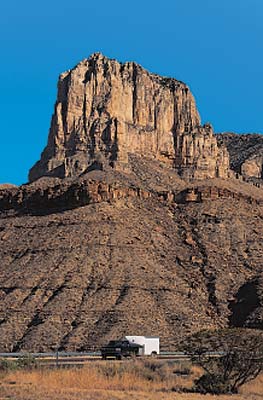Guadalupe Mountains National Park, Texas: Full of Secrets Waiting To Be Uncovered

It's difficult to believe that Guadalupe Mountains National Park, surrounded by the harsh Chihuahuan Desert, once brimmed with marine life. But that's just one of the secrets I learned in this obscure park tucked in the Texas Panhandle.
Opened in 1972, the remote 86,415-acre park includes the southern end of the rugged Guadalupe Mountain range. The ocean that once covered the area evaporated millions of years ago. But it left behind a 400-mile reef that stretches north all the way through Carlsbad Caverns in New Mexico–it's one of the world's best preserved.
Most of the reef remains buried, although you can see fossils on exposed rock in the high country, particularly on the Permian Reef Trail. And though you won't see living sea creatures here today, the wide range of terrain and climate fosters a staggering variety of plants and animals–900 kinds of plants, 60 species of mammals, 289 birds and 55 reptiles!
A Hiker's Paradise
Relatively few visitors have discovered this gem, and those who know about it come to hike. Scenic drives are almost nonexistent; roads mostly lead to hiking trailheads. However, four-wheel-drive vehicles are allowed to take a gated dirt road to the isolated Williams Ranch area on the south end of the park (a key to the gate is available at the Headquarter Visitor Center at Pine Springs, near the park's southeast corner).
The 80 miles of trails range from easy to challenging. Visitor Center exhibits helped me plan my routes and offered valuable information about possible high winds, extreme temperatures and sudden and severe storms and flash floods. I endured staggering winds of 100 mph during my stay!
From the Visitor Center, the paved Pinery Trail winds less than a mile to the old Butterfield Overland stagecoach station ruins. The easy Smith and Spring Trails, which start at the Frijole Ranch History Museum, about a mile east of the Visitor Center, lead to Manzanita and Smith Springs.
If you do nothing else, though, take the moderately strenuous El Capitan Trail to the base of El Capitan, a massive, sheer-sided promontory. This area landmark is mighty impressive!
Toward the park's northeast corner, I hiked along the flat Canyon Trail. It starts at the McKittrick Canyon Visitor Center and leads to a stone cabin once used as a summer getaway by Wallace Pratt, who donated much of the park's land. He often called this canyon “the most beautiful spot in Texas,” especially in fall, when the brilliant foliage rivals anything in New England. But I found the early-spring wildflowers equally breathtaking.
Serious hikers won't want to miss Guadalupe Peak, the highest point in Texas. It's a 3,000-foot ascent from Pine Springs Campground, where I stayed, to the 8,749-foot summit. But the scenery is so spectacular that I hardly noticed I was climbing the whole 4 miles.
I can't say enough about this special place. If you're in the mood to go take a hike, it just doesn't get any better!
Before You Visit
Guadalupe Mountains National Park is about 100 miles east of El Paso via U.S. Highway 62/180. Admission is good for 7 days and payable at the trailheads. Pets aren't allowed on most trails.
The Headquarters Visitors Center is open daily, except on Christmas Day.
The park offers two primitive drive-in campgrounds that offer water and toilets but no hookups or dump station. Pine Springs offers 19 RV sites (one is wheelchair accessible) and 20 tent sites; Dog Canyon, on the park's north side, includes four RV and nine tent sites. No campfires are allowed.
For more information, call 1-915-828-3251.



Leave a Reply